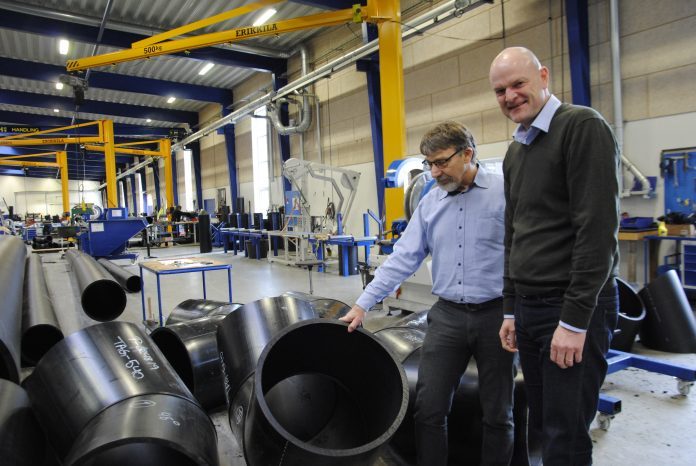Billund Aquaculture has been through an extreme growth journey in the last 10 years. The journey has been created by the growing demand for facilities that can operate the different phases of the salmon growth.
A man stands by his parked car in the wayside and scouts for planes from above. You should not think that much is happening right here, where one field meets the other, almost in the middle of the Danish map. But only five kilometres from Billund Airport, where one aircraft after another sets off lays world-leading RAS Technology company Billund Aquaculture.

It began with two brothers, one was a farmer and the other with a technical education, together they thought that they could establish a fish farming facility for farming eel. As an independent branch next to the company, they created Billund Aquaculture, in order to educate others to use the way the same technology they had used in their eel plant. Unaware that branch would become the backbone of the company’s future life.
“There is a 33% chance that the salmon you eat, no matter where you are on the globe, has been through one of our facilities,”says Christian Sørensen, chairman of the board and one of the founders of the company.
Many eels and later salmon have swum through Christian Sørensen’s developed RAS technology, which, according to them, is the world frontrunner. Today Billund Aquaculture have over 500 RAS plants for both salmon, trout, eel and yellowtail kingfish and with an explosive interest in clean land based salmon plants they see enormous potential in the future.
“Now I’ve had an eye on RAS plants for thirty years. When we built the first plant it could take 300 kg of feed a day and we were very proud of this. But today, the largest feed capacity per day is a unit that can take 9 tonnes of feed,” says Christian Sørensen.
Community
At Billund Aquaculture headquarters there is an open entrance plaza, where all offices on two floors lead out to. In the open area, light flows down from roof windows, and a staircase leads up from the first floor to the canteen. In the open landscape, as an employee, you cannot avoid meeting each other despite working in different departments. The offices have been converted into so-called clusters where different specializations can work together. From having open office landscapes, these smaller workspaces have created greater unity and better quality of work.

“This company is founded here in Billund, and even though we work internationally it is important that the values we are founded on remain. It is important to have the feeling of being one team,” says Christian Sørensen.

The company has several initiatives for employees with locations abroad to work together, so employees get the feeling of working for the same cause.
85-90% farming of salmon
Today, Billund Aquaculture no longer has their eel plant in Denmark, even though it served as a good model for costumers to see. But as eel became a more endangered animal species, sales fell. The head office for the company is still in Billund, while employees and offices have been established in Norway, Chile, USA and Australia.
Since 2006, when Chile, Norway and other countries first became aware of the benefits of growing salmon both post smolt, smolt and in grow out, demand for Billund Aquaculture’s technology has exploded. Today, 85-90% of Billund Aquaculture’s technology is used to breed salmon.
New management
In order to keep up with this development, a new management structure was needed. That is the reason why Steffen Busk Jespersen was hired as new CEO in August 2019. This is the first time SalmonBusiness has met him and he enthusiastically expresses his view on the development he is a part of.

“I was employed as we are going through a great growth journey and need to systematize and industrialize. We need to structure our growth, so we can keep up. We are the leaders in RAS and we must continue to be so,” says Steffen Busk Jespersen, and Christian Sørensen adds:
“We’ve spent 30 years becoming great at what we do. We want to continue to be the best and we believe we can, but we need to be able to keep up with the growing demand for our technology.”
Steffen Busk Jespersen came from a position as Managing Director for the Swedish operations of packaging and insulation group BEWiSynbra.
Competition motivates
Billund Aquaculture’s biggest competitors are AKVA Group, Aqua Partners and Krüger Kaldnes. But Christian Sørensen is not worried if more competitors follow.
“It is important to have competition in our industry because it is motivating. We have the ambition of maintaining our position as the absolute best. We have been building on all types of plants for the longest period of all and have the greatest capacity,” Steffen Busk Jespersen.

Billund Aquaculture believes their biggest challenge is if their market grows more than the 20%, they are expecting, as they will then find it difficult to meet demands.
“If the growth is 60% per year and not what we expect, it will be challenging to be able to meet that increase organically and be a sufficiently large player to satisfy customers,” says Steffen Busk Jensen.
By bringing investor Broodstock as a majority investor in 2017, the company hopes that if the market is to expand more rapidly, they will be able to keep up. Therefore, Billund Aquaculture also allocates 8-10% of revenue to innovation each year.

